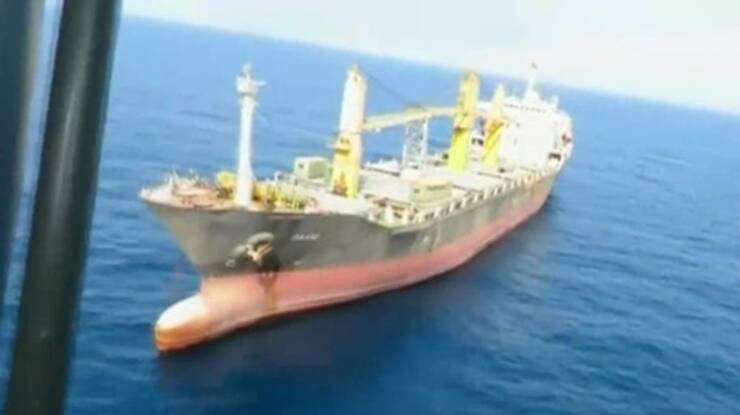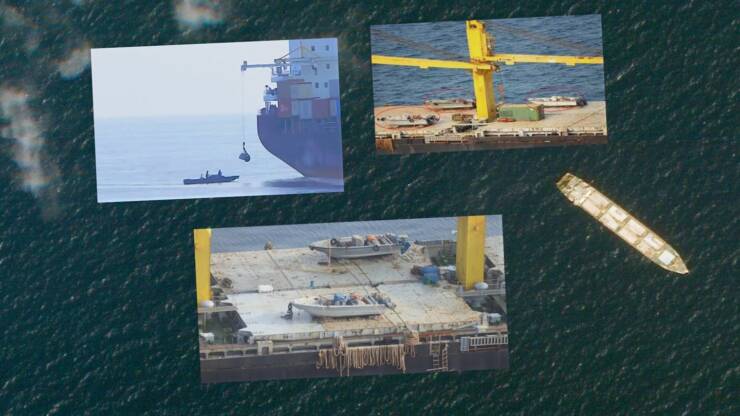
In early June, one of the largest ships of the Iranian Navy, the Kharaj, caught fire and sank in the Gulf of Oman. As of this writing, the circumstances of the ship’s burning are unclear. But beyond the story of the burning and sinking of the Iranian mother ship, there is an interesting opportunity for examining the Iranian strategic doctrine of operating the mother ships and the strategic development directions of the Iranian Navy.
The Kharaj was the main mother ship of the Iranian Navy, which was operated by it for long-endurance strategic missions as a mother ship for supply and logistics. The Kharaj also participated in two missions to Syria conducted by the Iranian Navy in 2011 and 2012 and several missions in the past years to supply oil and arms to Venezuela.
These missions of the Iranian Navy, in which the Kharaj participated, brought to the center of the Iranian consciousness the strategic importance of the Iranian Navy. The Iranian Navy has been relatively neglected since the days of the Iran-Iraq War. Since the war, Iran emphasized building the Revolutionary Guards Corps Navy (IRGCN), which is under the direct command of the Commander of the Revolutionary Guards and not under the Chief of Staff.
The Navy of the Revolutionary Guards is responsible for the defense and security of the Persian Gulf and the Straits of Hormuz. Over the past decades, Iran put its most efforts and resources into the IRGCN development; based on the point of view, it must compete with the US Navy, which has significant naval and air superiority.
Thus, based on coordinated “sting” attacks of dozens of vessels simultaneously, the Iranian asymmetric concept of warfare developed a wide range of multi-dimensional combat means – from the sea, under the sea, from the air, and from land, against the US naval ships.
The Revolutionary Guards Navy was equipped with many hundreds of high-speed boats, carrying onboard long-range (up to 250 nm) cruise missiles, wake-homing torpedoes, sea mines, advanced radars, and almost thirty midget submarines. And so, the force building of the regular Navy was abandoned, whose vessels became obsolete, as well as its combat systems.
In the last decade, the Iranian regime has realized that Iran must operate far away from the Iranian coast, in areas such as the Gulf of Aden, the Bab-al-Mandab straits, the Red Sea, and the Mediterranean Sea. Iranian operational activity in these areas will create deterrence for Iran. On the other hand, military and political achievements of power projection, intelligence gathering, and ensuring Iranian freedom of navigation.
The importance of Iranian freedom of navigation has increased, especially after the severe economic sanctions imposed on Iran by US President Donald Trump in 2018 and Iran’s inability to sell oil to world countries. Iran, which suffers from a severe economic crisis, has begun looking for creative ways to collect back again foreign currency for its economy. As a result, Iran has begun exporting pirated oil to various countries such as Syria, China, North Korea, and even Venezuela.

The United States threatened Iran for its moves, but Iran has passed through the rough seas to Venezuela, while the U.S. warnings sounded like the sea breeze going away.
This is where the shift in the importance of the Iranian Navy actually began. The Iranian Navy has been given a significant strategic role. It began to operate more and more and carry out strategic military exercises with China and Russia. However, those exercises were mainly diplomacy, showing the Iranian flag and creating deterrence against the United States, with the message that Iran is not alone on the naval battlefield Persian Gulf.
The Iranian Navy also began carrying out security and anti-piracy missions in the Horn of Africa and the Red Sea, patrol missions, intelligence gathering missions, and weapons transfer to pro-Iranian forces. Those missions demonstrated a Mediterranean and Pacific Ocean presence as the Iranian regime reflects its warning to the US and Israel on its capabilities to operate and attack close to their shores and not just from a distance.
The Iranian strategic ambitions started to be implemented by the Iranian navy reinforcement. New vessels and new submarines were built, the stockpile of weapons is refreshed, and it is equipped with the best anti-ship and anti-aircraft missile systems made by the Iranian industry. In addition, the Navy vessels were equipped with missiles developed and manufactured for the Revolutionary Guards Navy. The Navy also integrated unmanned aerial vehicles (UAVs) and unmanned surface vehicles (USVs) on board its ships.
The Navy began operating mother ships, such as the Kharaj, which would assist it in its long-range and long-endurance missions, far away from the Iranian coast. Just about three months ago, the launch of a new vessel, a mother ship, was announced, which was converted for military use from its original purpose as a merchant ship.
The new ship was photographed with a landing surface installed on board, from which helicopters, UAVs, USVs, and even missile launchers, mounted on trucks, can be operated. It is also possible that onboard the new ship, the Iranian Navy can carry semi-submersible and midget submarines for commando operations, intelligence gathering missions, underwater covert attacks, and shipping routes attack missions.
The Kharaj was a significant vessel for the Iranian Navy and enabled its warships to operate and carry out its strategic missions in blue-waters, far far from shore. But the Kharaj career was cut short by its drowning.
The Iranian Navy will quickly overcome the loss and probably convert additional merchant ships to its uses and support of its operational missions. Thus, despite the images of the drowning Kharaj, the Iranian Navy will recover quickly.
These days, right at the time of writing, another convoy of Iranian warships and merchant ships are making their way to the Pacific Ocean, bypassing Africa on their journey. However, their destination is not yet clear, and they may turn to Syria via the Straits of Gibraltar instead of continuing the planned journey to Venezuela. Thus, the Iranian Navy continues to operate and achieve strategic achievements for the Iranian regime.
–The writer is a former commander served in the Israeli navy for 23 years. A PhD in Defense and Security Studies, he was a senior consultant at the Israeli National Cyber Directorate. He is a recipient of various Israeli awards including Prime Minister’s Decoration of Excellence. The views expressed are personal and do not necessarily reflect the views of Raksha Anirveda








